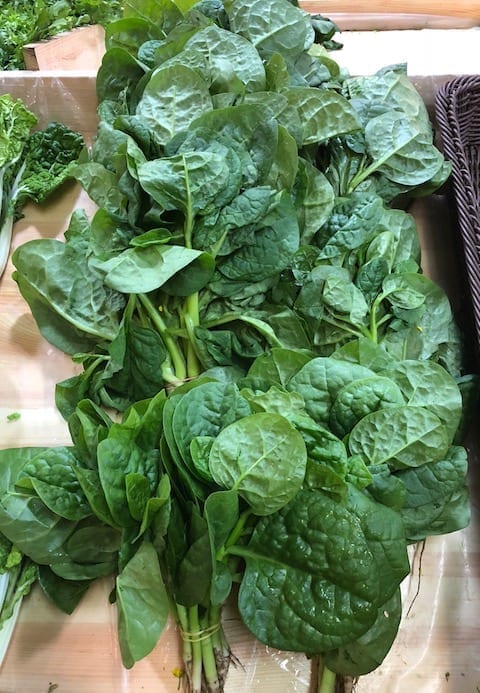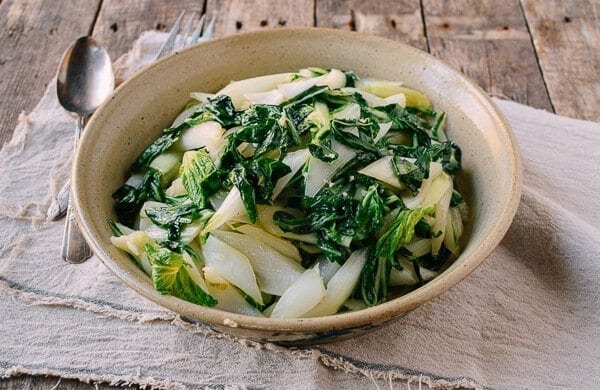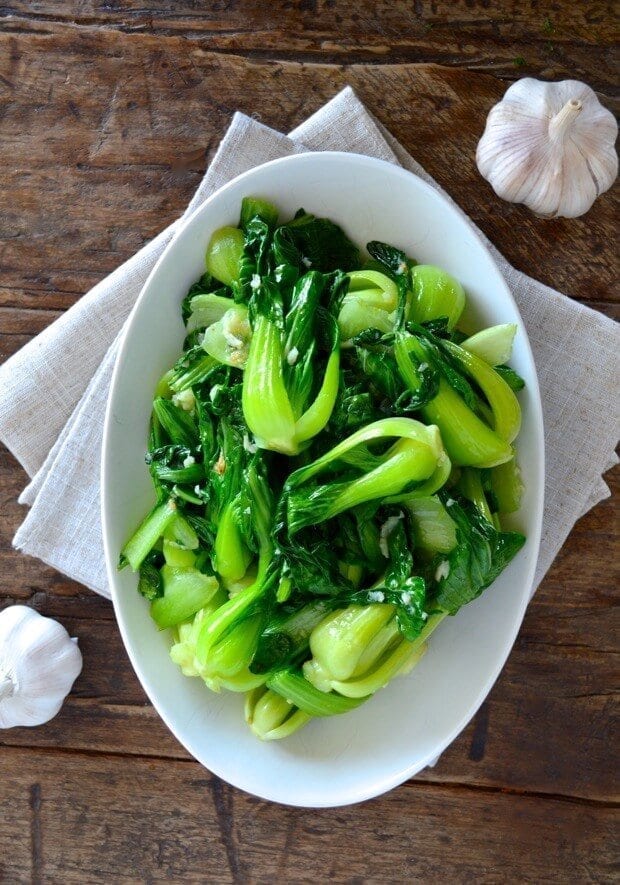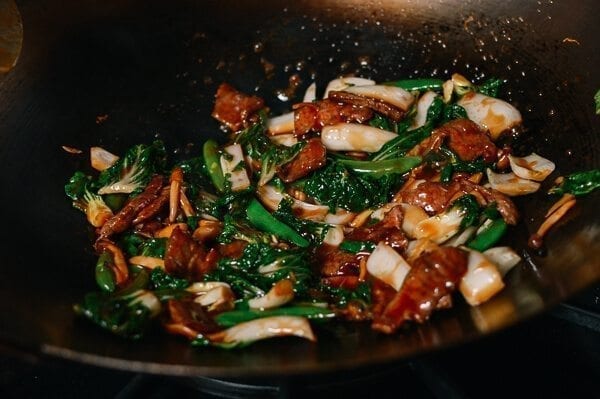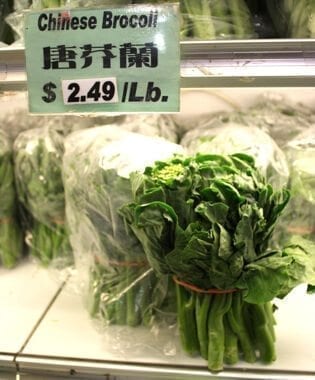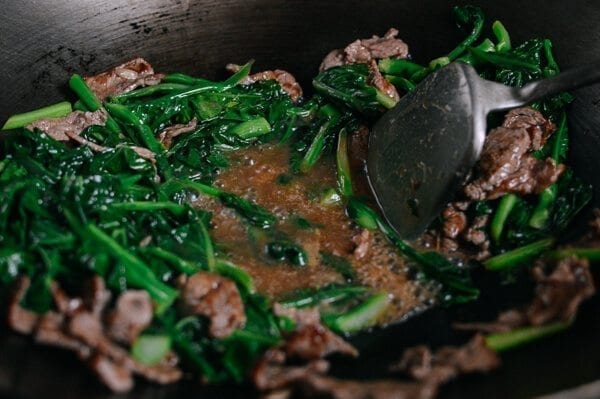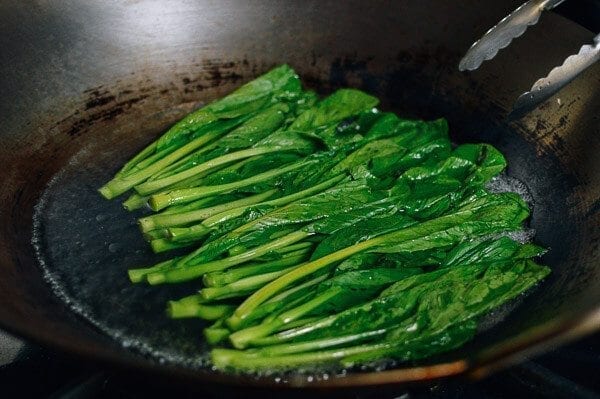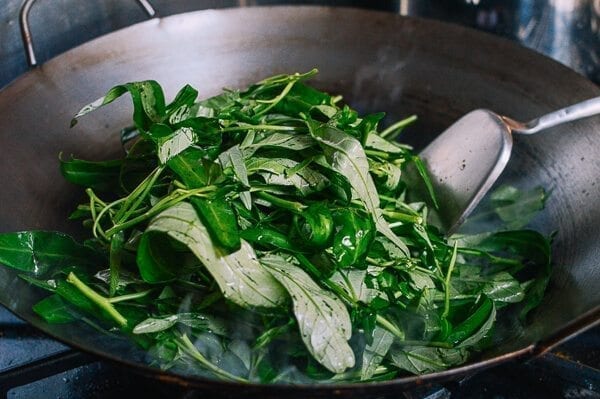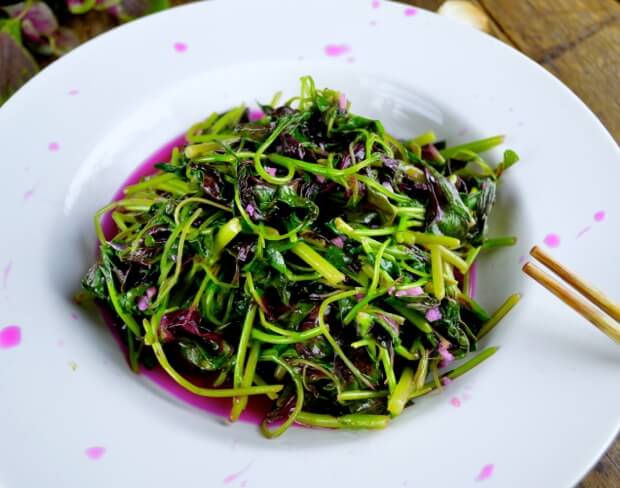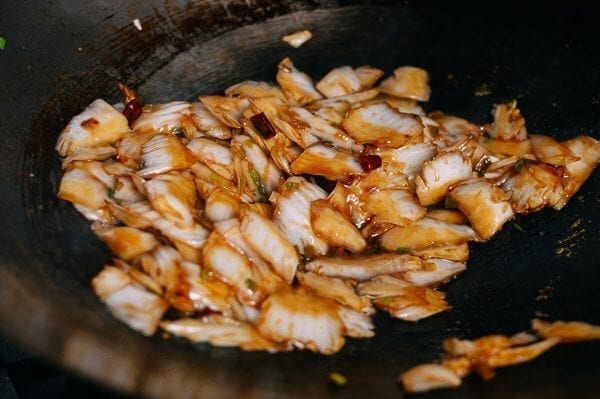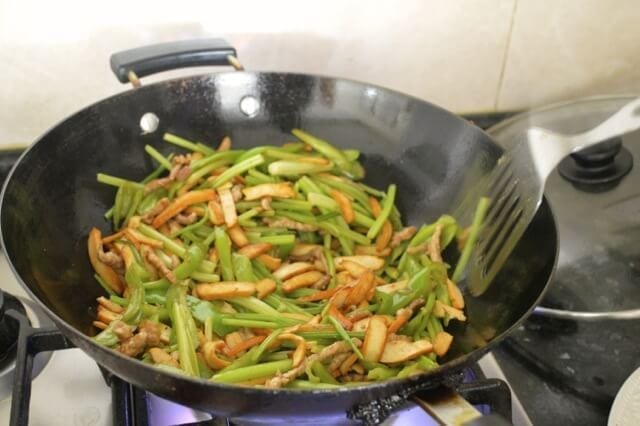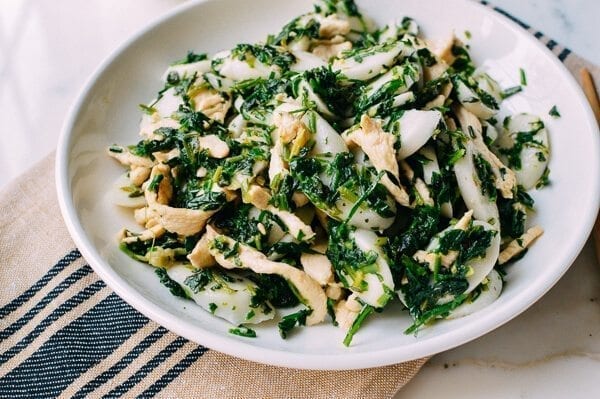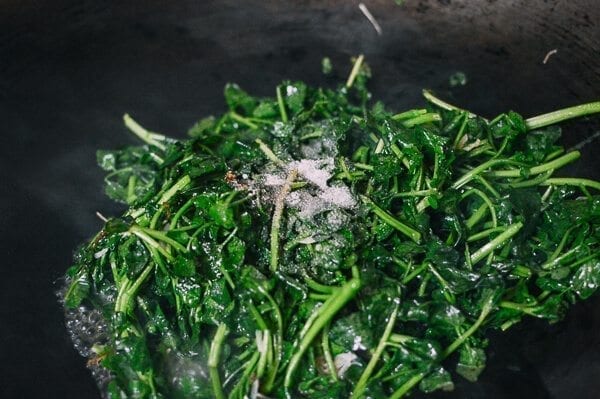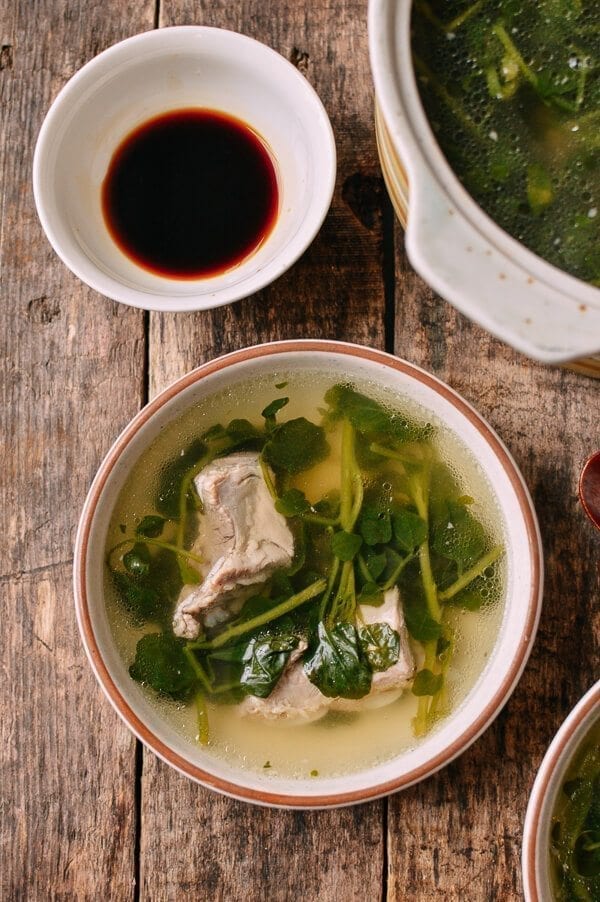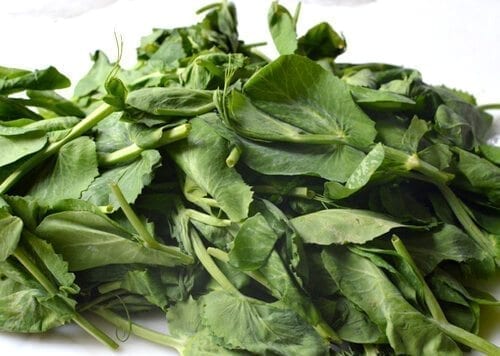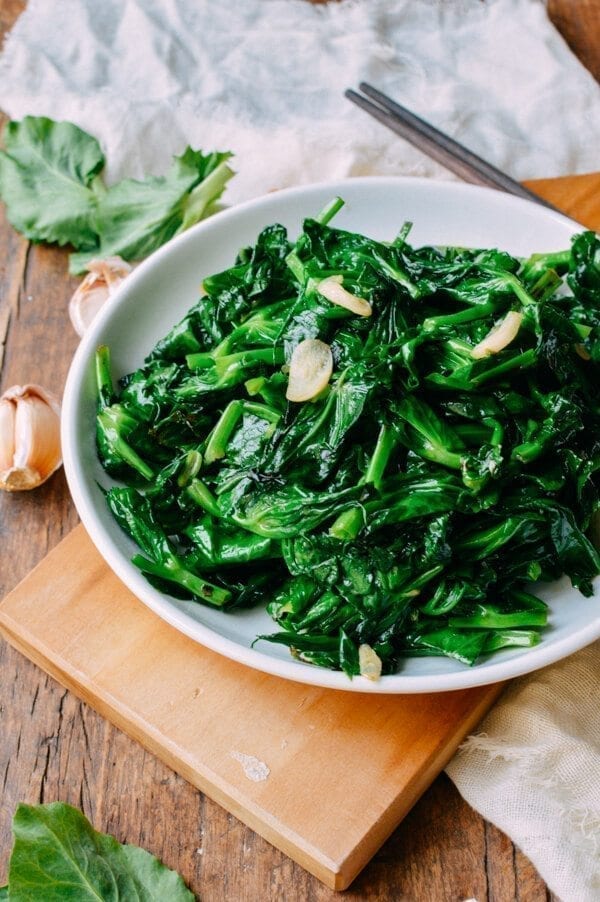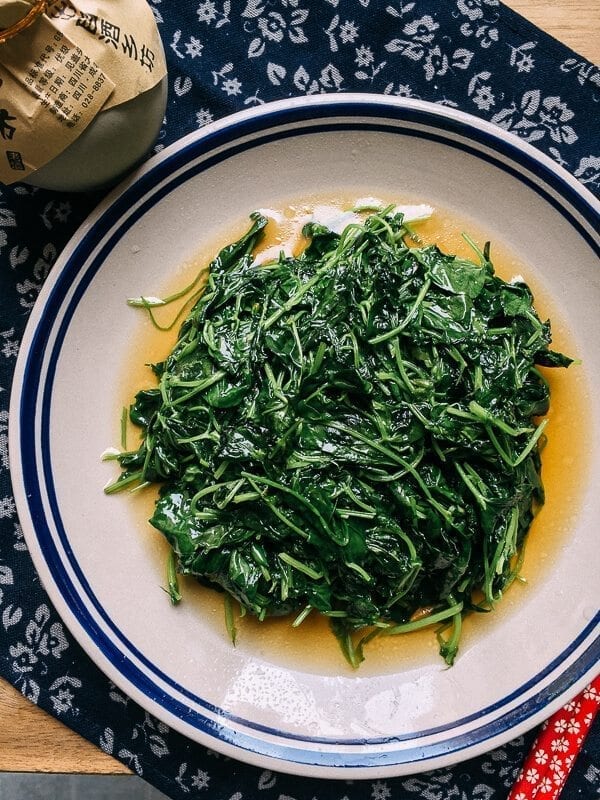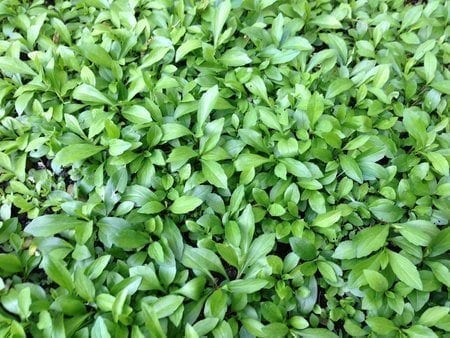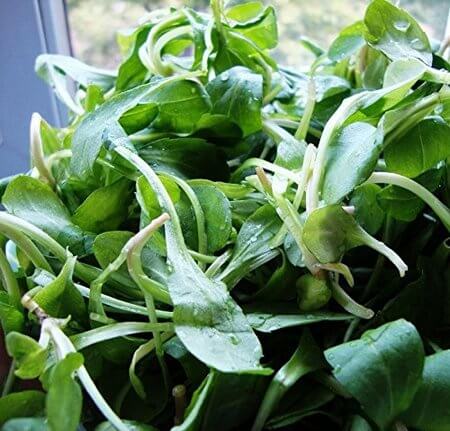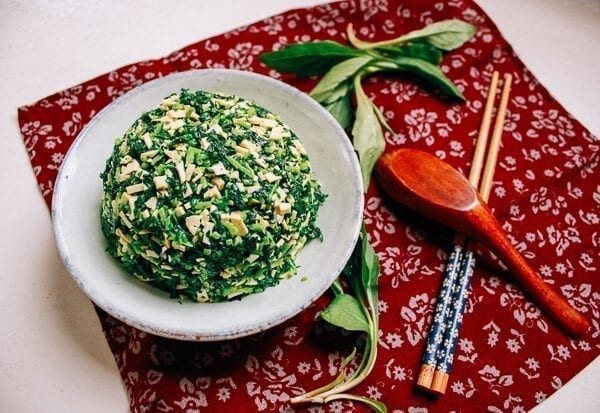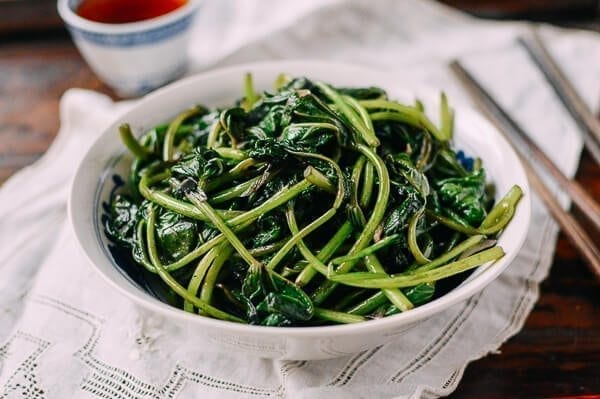BOK CHOY (白菜)
This Chinese vegetable, called bok choy, bái cài (白菜) and literally “white vegetable” has many different varieties that have made their way into everyday grocery stores. “Bok choy” is actually the Cantonese pronunciation of the vegetable and that name has stuck until now! There are three sizes, large, medium, and small. Often, you’ll find the gigantic ones with white stalks and large, dark green leaves. These are older and a little bit tougher, but still quite tender as leafy greens go. Kaitlin likes chopping it up for salads, as it’s surprisingly sweet and mild tasting.
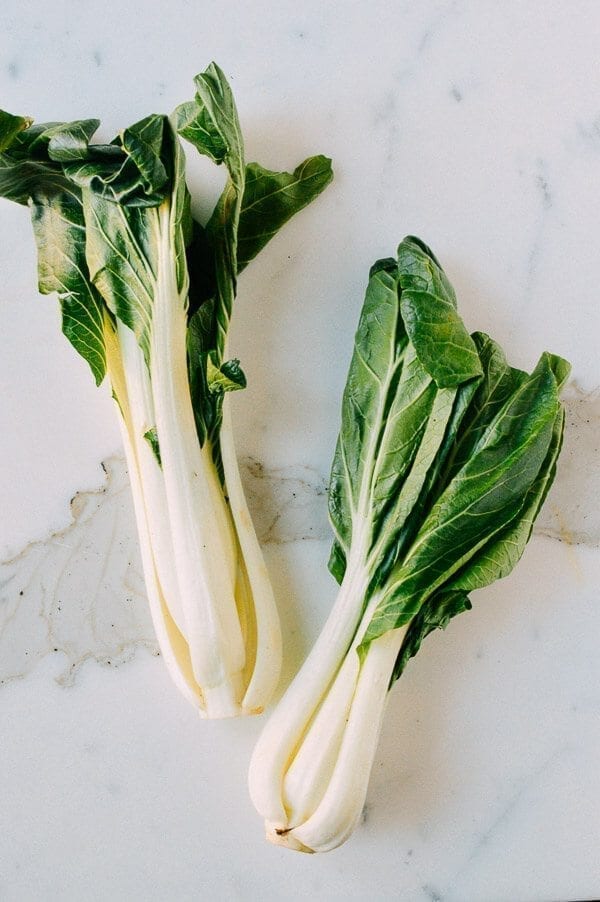
Check out our Basic Stir-Fried Bok Choy Recipe that uses the large white bok choy variety pictured on the left below.
For the majority of your Chinese dishes, however, you’ll want to go to a Chinese grocery to find the smaller, more tender specimens with fat, light green stems. These come in two sizes, regular (the aforementioned “medium”) and the small size. The smaller of the two is quite common today and our preferred. You may see it referred to as “green bok choy” or “Shanghai baby bok choy.” Be sure to try our super-simple Garlic Baby Bok choy recipe as a healthy side dish!
Below, you can see the difference in varieties between the white bok choy versus the green bok choy. In general, the white bok choy comes in larger plants and in general, the green bok choy are usually sold when they are younger and more tender. From our experience, the larger white bok choy is more readily available in supermarkets and are great for salads; but either is a delicious choice for a stir-fried green veggie side dish!
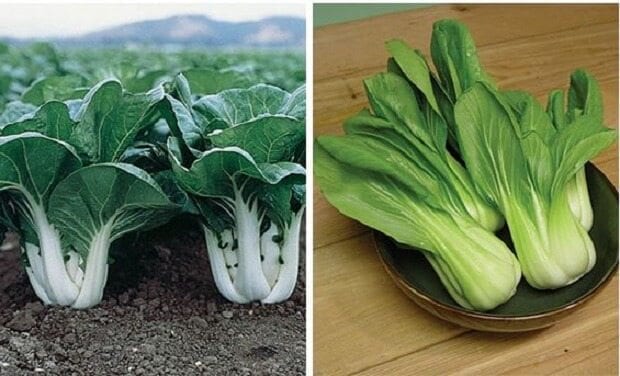
Check out these Amazon links for seeds to grow your own “white bok choy” and “green bok choy” in in your garden this summer!
Like any leafy green, these are typically pretty sandy, so be sure to wash thoroughly! Three soaks in cool water should do it. Make sure there’s no sand or dirt between the layers of each bunch. Cutting them in half or in quarters lengthwise prior to washing helps things along.
SHANGHAI BOK CHOY (上海白菜)
Shanghai bok choy is what we find in restaurants more often than not. They tend to be sold in smaller sizes as they’re more tender, but the larger size can still be found in most Asian markets. We love the smaller, tender and slightly sweet green bok choy vegetables for cooking at home.

In China, these beautiful Shanghai baby bok choy vegetables are arranged neatly in the grocery stores and wet markets.
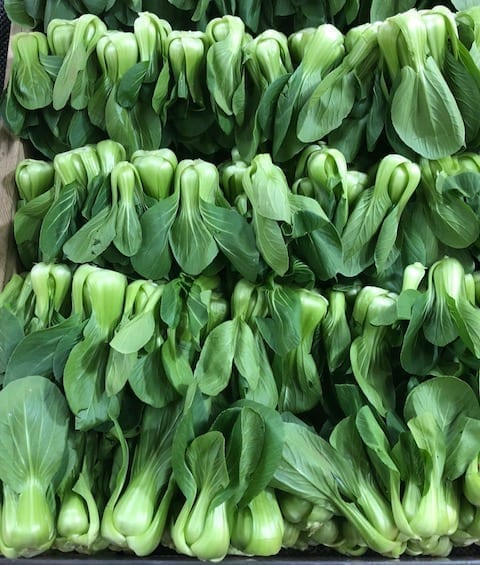
These compact tender bok choy plants not also taste better but they make for a much nicer presentation and are essential for dishes like the Braised Chinese Mushrooms with Baby Bok Choy.
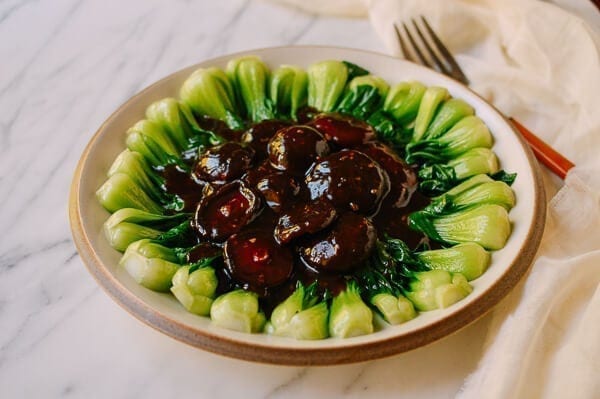
DWARF BOK CHOY (奶油白菜)
In Chinese grocery stores, dwarf bok choy are sometimes called and labeled as 奶油白菜 or nai you bai cai which translates to “cream bok choy” (don’t ask me who comes up with these translations!). These dwarf bok choy look like a miniature version of the classic white bok choy you find in supermarkets but they are actually a special variety or hybrid of bok choy. These white bok choy haveare a bit stubbier, and the dark green leaves are distinctively curly and sweet tasting!
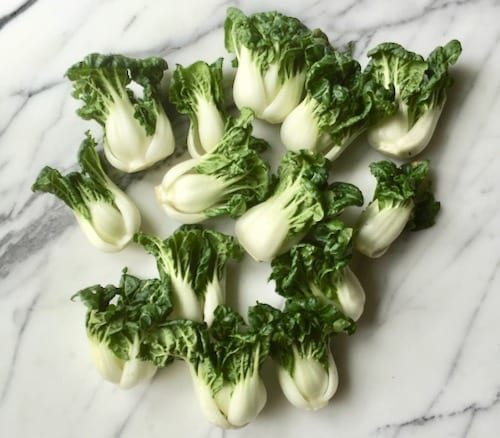
You can see how we prepared and used this dwarf bok choy in our quick and easy beef vegetable stir fry.
This dwarf bok choy variety has become more common. A well-stocked Chinese or Asian market should have many bok choy varieties for you to choose from! You can even grow these at home if you like to garden by purchasing your own extra dwarf bok choy seeds!
CHINESE BROCCOLI (芥兰)
This Chinese broccoli, jiè lán (芥兰, Mandarin) or gai lan (Cantonese) looks nothing like your garden-variety florets. Even though it shares the same family as regular broccoli (which is known as xī lán huā, 西兰花 or literally western broccoli), Chinese broccoli has long green stems and dark, thick leaves. Some compare it to broccoli rabe, and sometimes jie lan will be harvested with edible flower buds in small bunches. However, Chinese broccoli is sweeter and much less bitter than broccoli rabe.
These days, it’s quite easy to find Chinese broccoli in certain supermarkets that stock Asian produce. (If you’re lucky, you can find baby Chinese broccoli, also called Chinese broccoli tips, in certain Asian grocery stores.) When shopping for this leafy green, try not to select stalks that are too thick, have too many open flowers, or have yellow leaves. This means the veggie is old, tough, or simply not fresh.

One preparation tip that many of you have asked about in the comments is how to deal with those thick stems. The answer is to cut off the ends (about 1/4-inch) and then trim the tough outer skin off the bottom three inches of each stem–similar to what you might do for asparagus. If making a stir-fry, you can then then cut them at an angle or in slices. If you are blanching and serving them whole with oil and oyster sauce, just trim the base of the stem where they are tough until you reach the tender portions and you’re ready to go! You can see a nice picture of the trimming job in our simple yet favorite Chinese Broccoli with Oyster Sauce.
And an extra fun fact–ever see those expensive bunches of “broccolini” in your local supermarket? That’s just your regular old cafeteria broccoli crossed with this Chinese broccoli. Mix ‘em together, and you’ve got a fancy little name, plus supermarkets charging $3.99 for a tiny bunch. Go figure. The price of Chinese broccoli, like all vegetables, is seasonal but prices are quite reasonable and usually cheaper in Asian grocery stores.
I like all three varieties of broccoli, but Chinese broccoli is a key ingredient in dishes like the simple Chicken with Chinese Broccoli . You can see how we prepared the Chinese broccoli in our recipe post for Beef with Chinese Broccoli.
CHINESE CHOY SUM (菜心) OR YU CHOY(油菜)
Choy sum or cài xīn (菜心, in Mandarin) or yóu cài (油菜, yow choy in Cantonese), is a another common and popular Chinese leafy green vegetable. Although it looks similar, it should not be confused with Chinese broccoli. The taste of choy sum is much sweeter and more tender than the Chinese broccoli. The texture of these is a bit closer to bok choy. We love these because they are mild in flavor and go great as a side dish or addition to tons of different dishes.
Yu choy is literally translated as “oil vegetable” because it is in the family of rapeseed and is actually used to produce oil. Another fun fact is that a variety of yu choy or rapeseed is grown primarily to produce canola oil, one of our go-tos when cooking.
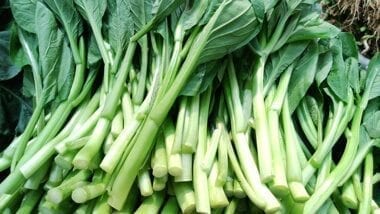
Choy sum is literally translated as “vegetable heart” which refers to the edible stem or stalk you see in the picture below. These vegetables are generally grown until the plant just begins to show signs of shooting and flowering, but these days, they are also picked early as young plants–about 3 to 4 inches high. This is when they’re at their best. Home gardeners frequently cut the tips off to let the rest of the plant grow more between trimmings. We grow these in our garden and hope to share a post and pictures one of these days. These choy sum vegetables cook up nicely. This versatile dark green, leafy vegetable can be sautéed, added to soups, stir-fried, or blanched alone.
Our Easy Chinese Yu Choy Sum vegetable side dish is done in 5 minutes! Flavor agents include soy or oyster sauce, ginger, and garlic. But this is really just the tip of the iceberg. Sarah came up with a unique Creamy Roasted Choy Sum Pesto Pasta that is definitely worth checking out! Aside from that, it is used as the green veggie in quite a few noodle dishes like 15 Minute Chinese Hot Oil Noodles (You Po Mian) or Pan Fried Noodles with Chicken (Gai See Chow Mein).
CHINESE WATER SPINACH(空心菜)
Chinese Water spinach is a long, leafy green vegetable with hollow stems that is grown in water or damp soil. It also goes by the name of ong choy in Cantonese or kōng xīn cài (空心菜) in Mandarin, which translates to “hollow heart vegetable”. It’s commonly known as Kang Kung in Southeast Asia, but in our family it’s known as the “hollow veggie,”a name given to it long ago by two young Chinese girls trying to order some good food at a restaurant without a lick of Chinese under their belts (yah, that’s Sarah and Kaitlin!).
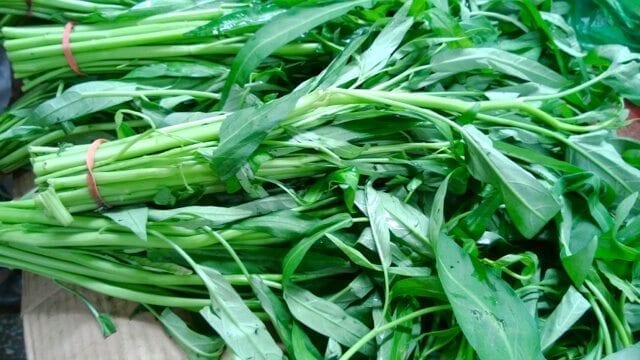
Chinese Water Spinach is sold in large bunches at the market. In fact, the stalks can get as long as eighteen inches. When cooking these Chinese vegetables, they are cut into 3-4 inch lengths and cooked with garlic and fermented bean curd or belacan shrimp paste. Surprisingly, even the hollow stems are quite tender as long as the lower 1-2 inches of the stalks are trimmed away. Recently, we saw young and tender water spinach in the market which is a delight to prepare and eat. Just give it a quick rinse–no trimming is needed since everything is tender and edible.
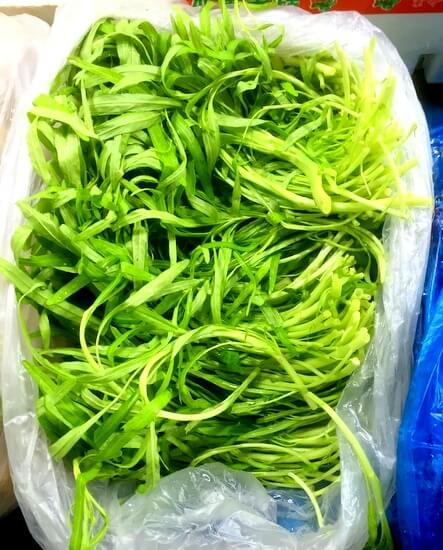
We also recently learned that Chinese water spinach is considered an invasive and noxious weed in some parts of the country, but, for now, its cultivation and sale is still allowed. Just do you part to eat them and we won’t have a problem! 🙂 We have a very early post on preparing Stir-Fried Water spinach, but if you prefer a fancier dish from Hong Kong, then try our Stir fried Ong Choy with XO Sauce!
CHINESE SPINACH OR AMARANTH (苋菜)
Sometimes called Chinese spinach, pronounced in Cantonese as hin choy and in Mandarin as xian cai (苋菜), this leafy green vegetable is best stir-fried simply with garlic and salt, as it’s similar in flavor to spinach.
There are two varieties: one with a deep magenta color in the center of the leaves, and the other a light green. The green variety actually grows in the wild, at least, according to our experience. When Bill was young, his mother discovered that it had made its way into her garden somehow, and it just came back every year like a perennial. She called it “horse poop vegetables” or in the Hakka dialect, “ma see hen tsoy” because in China, these veggies thrived growing in horse poop! Tastyyy…All jokes aside though, you can find these in Chinese grocery stores and, we have found, in Indian grocery stores! Though we’re not sure how they’re used in Indian cuisine. When buying these, look for bunches that don’t have any budding flowers, which is an indication that they’re too mature and may be tough.
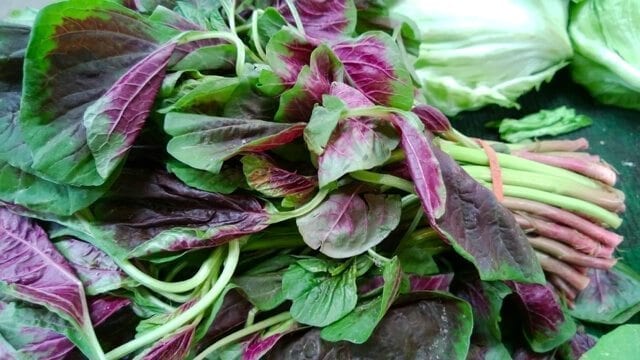
You can check out our recipe for Stir-Fried Pink Amaranth Greens.
CHINESE NAPA CABBAGE (大白菜)
Napa cabbage is large, pale green, and very mild in flavor. Napa cabbage originated near the Beijing region of China, so it was no surprise to us to see napa cabbages sold at Beijing wet markets by the truckloads! In Mandarin, it’s called da bai cai (大白菜) which translates into “big bok choy.” Bok choy, cabbage, who the heck knows when translating from Chinese to English and transporting from China to America. (Hence, this guide!!!). In Cantonese dialect, my parents always used to refer to napa cabbage as “wong nga bok” .
Napa cabbage is used in soups, stir-fries, slaws, and many noodle and dumpling dishes. The water content of this vegetable is quite high, and, when cooked, it has a pleasantly sweet and juicy taste to it. It’s a vegetable frequently used when making pot stickers or pork buns but is definitely the vegetable of choice when making Shanghai Style Spring Rolls or Stir-Fried Rice Cakes (Nian Gao). It’s also the vegetable of choice for lo mein noodle dishes; we use it in our recipes for Beef Lo Mein and Vegetable Lo Mein.
Chinese Napa Cabbage can usually be found in mainstream supermarkets. Make sure to pick cabbages that feel firm and are pure in color (i.e. without any tiny brown or black spots, which means they’re not fresh). If your cabbages develop these little spots as they sit in your refrigerator, the flavor will likely have turned bitter. Life is just too short to be eating old napa cabbage that will ruin your lo mein, so be prompt with these when you bring them home from the supermarket!
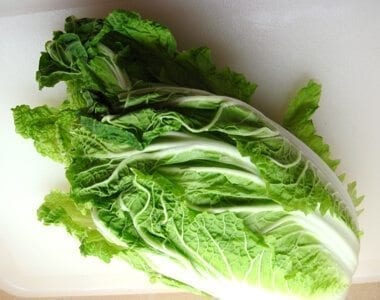
Perhaps the quickest yet most satisfying home cooked dish is our Sichuan Napa Cabbage Stir-fry (Suan La Bai Cai).
TAIWANESE CABBAGE
Taiwanese cabbage is a flat pumpkin-shaped cabbage and is a much better alternative to your standard round green or purple cabbage found in most supermarkets. These Taiwanese cabbages, also sometimes known as Chinese cabbages might not look like your everyday cabbage, but they taste much sweeter and crunchier even after they’ve been cooked. Try this variety of cabbage for your stir fry dishes, and trust me, you’ll never look back!
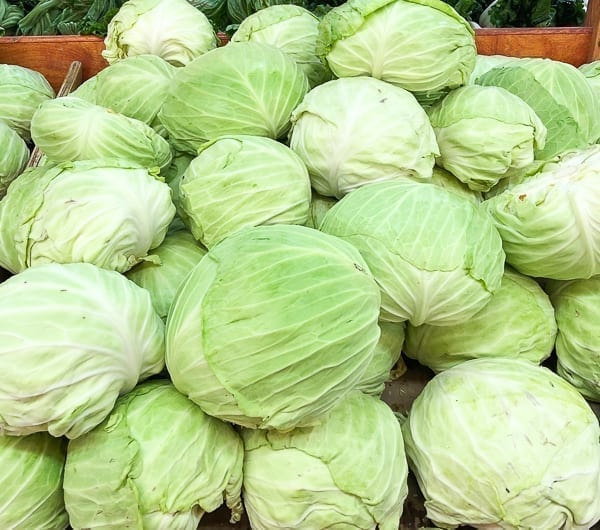
SAVOY CABBAGE
Savoy cabbage is similar to everyday white cabbage found in most supermarkets but has subtle differences. Due to its wrinkled patterned in their leaves, Savoy cabbage is also known wrinkled cabbage. From this wrinkled look, one could speculate that they are a cross between your standard cabbage and a napa cabbage. Whatever the origin, we do know that the flavor of savoy cabbage is less harsh than your standard cabbage yet has much less water content than napa cabbage so it’s great for stir fries and egg rolls.
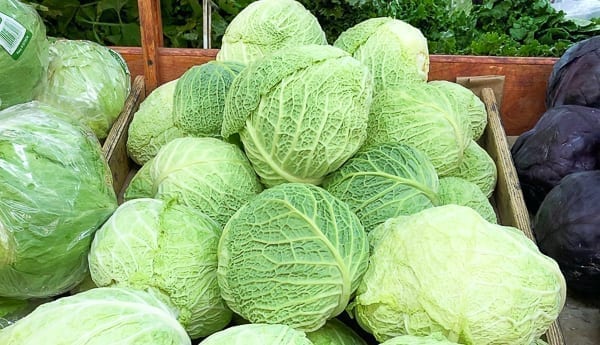
CHINESE CELERY (芹菜)
Chinese and western celery 芹菜, pronounced qín cài in Mandarin and “kun choy” in Cantonese both have the same name even though they are quite different. Chinese celery is longer and thinner than regular celery and has a very strong celery flavor. Even the most tender batch of Chinese celery can be a little tough and pack a ton of fiber and celery flavor. Similar to the western variety, the stalks are mostly consumed since the leaves are usually way too bitter. Chinese cooks use this celery mostly for stir-fries, and it does produce a great flavor.
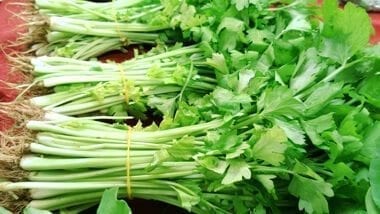
We have one dish in our collection that is an oldie but a goody: Jen’s Tofu Stir-fry. Although the recipe calls for common celery, we usually use Chinese celery.
SHEPHERD’S PURSE (荠菜)
Shepherd’s purse or jì cài (荠菜) is a leafy green wild vegetable that’s eaten most commonly in and around the Shanghai area. I’m not sure if there is a Cantonese pronunciation because I never heard of or tried jì cài before I met Judy. Jì cài can be added to soups and porridges, but it’s probably most popular as a filling for dumplings, won tons, and steamed buns alongside ground pork. It has a really unique flavor, and, although it’s available fresh in China, it’s usually only available frozen in the U.S (which is just as well, because we’ve found that these delicate leaves are very sandy and a pain in the neck to clean!). Nowadays, shepherd’s purse is cultivated and it seems that everyone in Shanghai over 50 years old says the cultivated varieties don’t come close to the strong aromatic flavors of the wild varieties they used to eat. But every so often we get a particularly good batch nonetheless! Look for it in the frozen vegetable section of your Asian grocery.
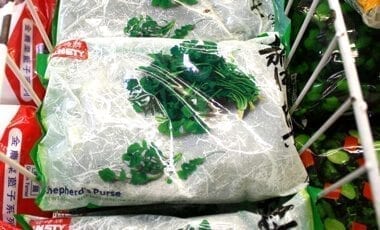
If you can’t find it in your local Asian market and you have a garden, buy some Shepherd’s purse seeds and grow it yourself! Once you have tried it, especially in wontons or dumplings and potstickers, you will know why it’s worth the trouble! They grow easily like weeds but because they do look like weeds, be sure to keep a picture handy! Here’s a picture and link to reference fresh Shepard’s purse!
We have quite a few dishes in our collection that use Shepherd’s purse, probably because our family loves the flavor and because Judy is from Shanghai. But Shanghai or not, if you have access to this tasty green veggie, then you must try it! It’s a key ingredient in the dumpling recipe we’ve been making for years: The ONLY Dumpling Recipe You’ll Ever Need. Another family favorite that uses Shepherd’s purse is the Shanghai Sticky Rice Cake Stir-Fry. We ate this dish quite a bit in China, so we’re all too pleased that we can recreate it back in the US.
CHINESE MUSTARD GREENS (芥菜)
Chinese mustard greens or jiè cài (芥菜) in Mandarin and gai choy in Cantonese, sometimes called Indian mustard, leaf mustard, or mustard cabbage, is a very healthy vegetable. We don’t use it much because it is kind of bitter (well, very bitter)–so much so that it’s usually cooked with lots of ginger and some sugar to take the edge off. On the bright side, most, if not all bitter vegetables, including these mustard green Chinese vegetables are very healthy!
Chinese mustard greens are also used to make picked vegetables, which we DO eat fairly often. It’s sometimes eaten alone with congee but is most often used for cooking dishes like pickled mustard cabbage with squid or pickled mustard cabbage with chicken. Other recipes we have that use pickled or preserved mustard greens include Mei Cai Kou Rou (Steamed Pork Belly w/ Preserved Mustard Greens) and Noodle Soup with Pork and Pickled Greens.
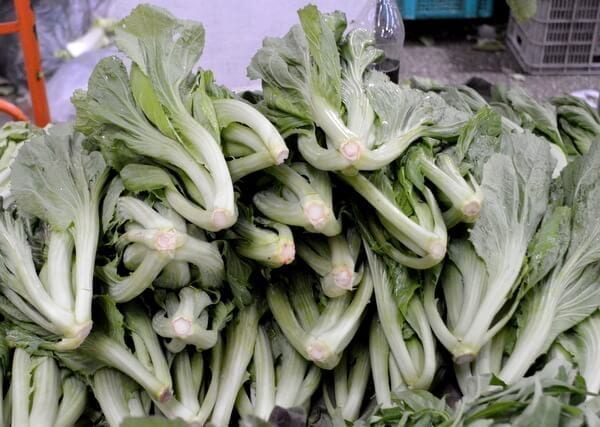
WATERCRESS (西洋菜)
Watercress or xī yáng cài (西洋菜) also pronounced “sai yeung choy” in Cantonese, is another one of those vegetables our family eats quite often. It’s a rather mild tasting vegetable when cooked, but tastes somewhat peppery when eaten raw (think arugula). Like the name suggests, it is an aquatic vegetable that thrives in cold water and is quite commonly found in the wild. Bill probably has the most experience with this; when growing up in upstate New York, he and his family used to drive up to a little known spot deep in the Catskills to pick big bunches of watercress that grew in the spring-fed streams. This place got to be quite well-known amongst the four (or was it five?) Chinese families that lived in Sullivan county, NY, and the women of these families would make periodic drives to pick bunches and bunches of fresh, wild-grown watercress together. Those were the days!
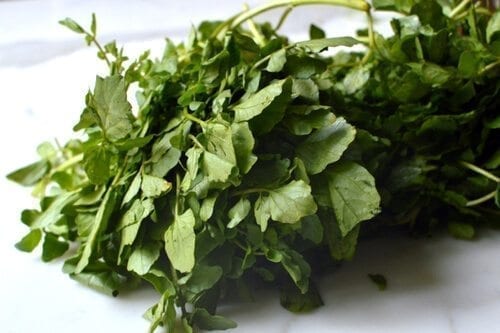
A little more recently, we found watercress in Sedona, AZ while on a family trip. Being the hunters and gatherers we are, we had a fine side dish that night to go with the grilled chicken and steaks at the timeshare where we stayed. But when we can’t get it in the wilds of good old North America, we settle for a few bunches at $1.29 apiece at our supermarket. 2-3 bunches is usually the optimal amount for a nice side dish. Enjoy this vegetable is a quick and easy stir fry using our recipe for Healthy Stir Fried Watercress with Garlic recipe.
Or maybe drop it in a Sai Yeung Choy Tong soup to warm you up in the cold weather!
PEA SHOOTS, PEA LEAVES, OR PEA TIPS (豌豆苗)
Pea shoots, wān dòu miáo (豌豆苗) or simply dòu miáo (similar pronunciation in Cantonese) is a tasty vegetable that is readily available these days in many restaurants and Chinese markets. “Pea leaves” is probably the most accurate description for this veggie as the plants that are harvested are more than just sprouts with fairly large leaves as you can see from the picture below. In fact, I think the larger leaves are actually more tender than the smaller sprouts you sometimes find that are cut when they are only 3 to 4 inches high!
Dòu miáo has become fairly popular recently, but the big season is during the fall and winter when you can get them more readily and for more reasonable prices (at least here in the US Northeast). Our theory on this is that during the spring and summer, farmers are growing beans and peas for the beans and peas! So there’s no reason to harvest the leaves; during this time pea leaves may sell for as high as $6.49 a pound. Yes, they are light in weight but $6.49 a pound is starting to approach close to the price of a good cut of beef! (Makes us miss Beijing wet markets, where we could get plentiful seasonal vegetables for a fraction of what they cost in the US!)
We recently posted a Stir-Fried Pea Tips dish that looks great and tastes even better, especially if you’re a lover of leafy greens, like us. Give it a try if you can get your hands on some of these tender leaves!
CǍO TÓU – EDIBLE CLOVER (草头)
Edible clover or cǎo tóu (草头) has a sweet and light grassy flavor, and cooks very quickly. Although some types of clover are edible, there are different varieties––some of which can be toxic. Like mushrooms, you have to know what you’re doing if you want to go out and forage for them. This is another vegetable where I am at a loss how to pronounce in Cantonese so best to use the Mandarin name and pronunciation.
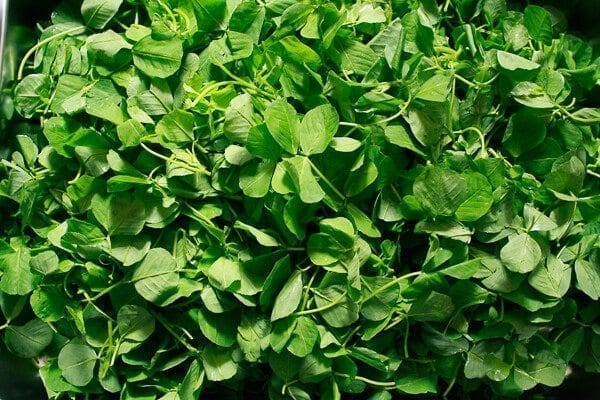
In any event, the safest path is to have them in restaurants or to buy them from the market. The catch is that I have only seen them sold in Shanghai vegetable markets and only in spring which is why we would classify this as a Chinese vegetable! We have the Shanghai style Stir Fried Cao Tou recipe here, which is really easy to prepare!
TONG HO – EDIBLE CHRYSANTHEMUM (茼蒿)
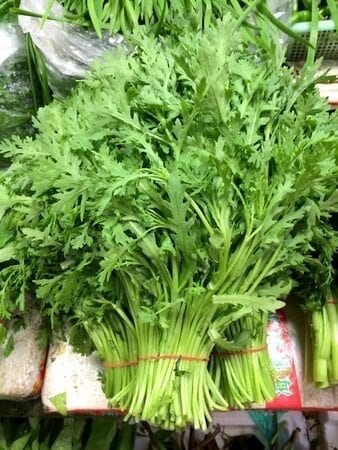
Edible Chrysanthemum or tóng hāo (茼蒿) or simply “tong ho” in Cantonese, comes in two main varieties. One variety is small or medium leaf tong ho pictured below with small and deeply serrated leaves. This variety is commonly offered in Chinese restaurants as a stir-fried leafy green vegetable. Tong ho has a unique, aromatic, and bitter flavor when harvested early.
Large or broad leaf tóng hāo (茼蒿) has rounded and wider leaves with much shorter stems. This variety often comes stir fried or as an add-in for hot pot. From our experience, the broad leaf variety has a stronger aromatic flavor than the smaller leaf variety.
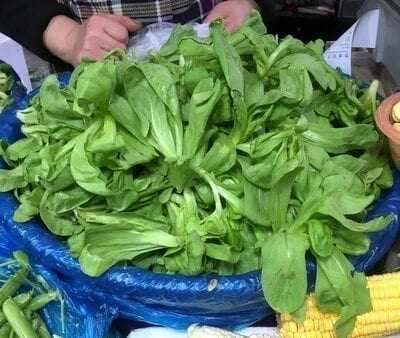
MA LAN TOU (马兰头)
Ma lan tou (马兰头), also known as kalimeris indica, Indian aster or Indian kalimeris, is a flowering perennial and one of the many favorite vegetables of the Shanghainese. Although ma lan tou can be found across eastern Asian countries, we discovered it in a wet market in Shanghai during our visit in spring of 2016.
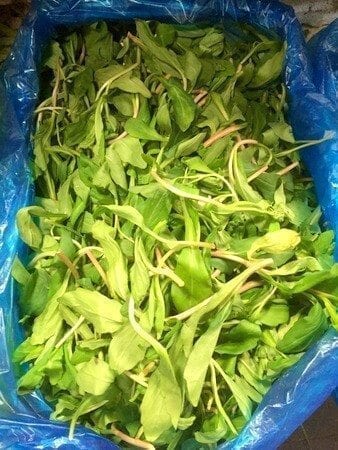
Young leaves and stems are collected in early spring and are considered a delicacy because of the special flavor, which may remind you of tong ho (茼蒿), edible chrysanthemum leaves. We’ve rarely found this here in the US, but there are a handful of Amazon sellers offering live plants and seeds, which you can find via the links below.
Chinese Herb (Ma Lan Tou, 马兰头),Also Called Indian Kalimeris, 20 Live Plants
We may try planting them in our garden next season so we can enjoy both flowers and a harvest of vegetables!
100 Kalimeris Indica Natural Wild Vegetable Seeds
Try our recipe for this classic Shanghai dish, Ma Lan Tou Spiced Tofu.
YAM LEAVES – DÌ GUĀ MIÁO (地瓜苗)
Sweet yam leaves, or sweet potato leaves, have a long string of nicknames in other parts of the world. “The queen of vegetables!” “The longevity vegetable!” “The anti-cancer vegetable!” Yam leaves have a shape like a heart with long stems and have a very mild flavor and although they are not considered one of the more common Chinese vegetables, this healthy leafy green is very popular among Chinese people.
Some research has shown that yam leaves are more nutritious than spinach, celery, carrots and cucumbers when it comes to vitamin B, iron, zinc, protein, antioxidants, and calcium. They are also rich in vitamin A and C and supposedly enhance immune function, boost metabolism, lower blood sugar, improve eyesight, and act as an anti-inflammatory.
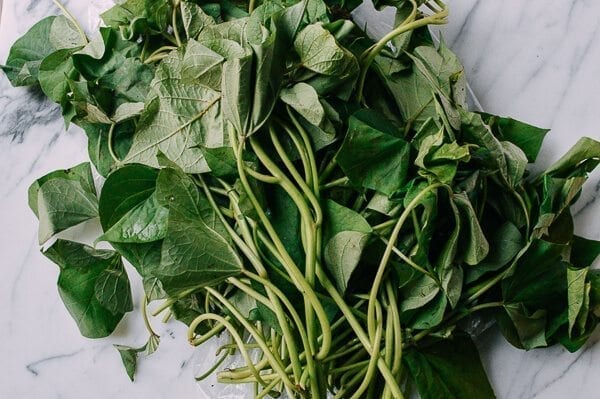
Make sure that you are eating sweet potato leaves and NOT potato leaves in the nightshade family that contain solanine, which is toxic to humans. Just get your yam or sweet potato leaves at a reputable Asian grocery store, and you’ll be just fine. Check out Judy’s recipe for stir fried yam leaves (di gua miao)!
AA CHOY – AA CAI (AA 菜)
AA Choy is the leafy portion of celtuce or wo shun and is a common leafy green vegetable that is very popular in both Taiwan and China. Wo shun is the large edible stem portion of the plant when it matures and is usually sliced like a bamboo shoot and used in authentic pork with garlic sauce. AA choy is a refreshing leafy green that tastes a lot like romaine lettuce (not quite as crunchy) and is usually stir fried with fresh chopped garlic or blanched and served with an oyster sauce topping (similar to yu choy sum).
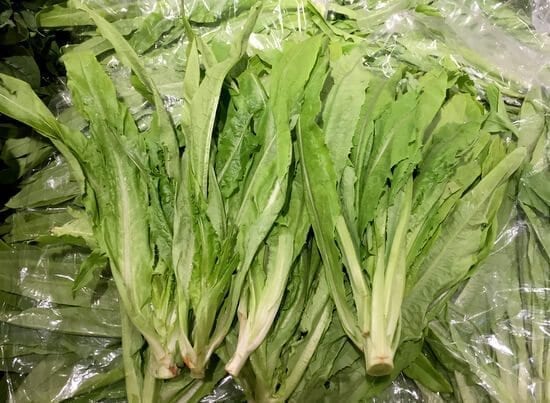
TAIWANESE SPINACH – TÁIWĀN BŌ CÀI (台湾菠菜)
Taiwanese Spinach is a tall dark green leafy vegetable with long stems. Looks are deceiving though because the stems of the Taiwanese spinach are quite tender and packed with flavor and nutrients! Taiwanese spinach tastes similar to common spinach we usually see in supermarkets, but it is milder in flavor. Don’t confuse this vegetable with amaranth or water spinach, which are quite different! This is a great vegetable to have stir fried with fresh garlic or simply cooked quickly in any traditional Chinese soup.
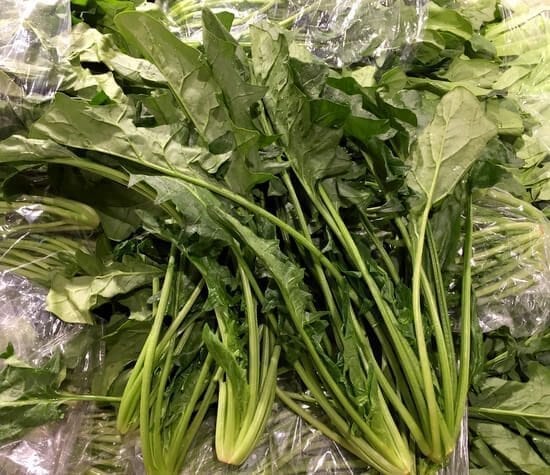
MALABAR SPINACH (木耳菜)
Malabar spinach or木耳菜, pronounced mù’ěr cài in Mandarin is commonly found in China but is still rare in the US and other western countries. Mù’ěr cài is translated directly as “wood ear vegetable” and is similar in consistency and texture to cooked okra. Malabar spinach tastes similar to spinach and is used often in soups and in hot pot, but like almost every vegetable on this list can be simply stir-fried with garlic, salt, and oil.
